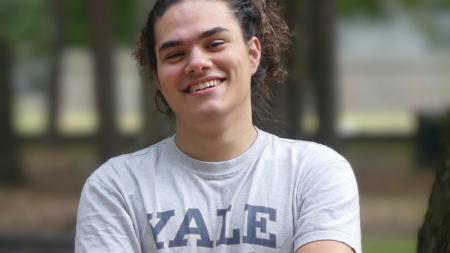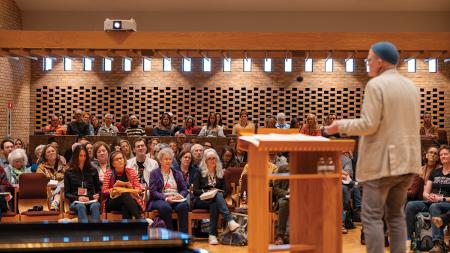CRC Group Deeply Affected by Visit to Selma

CRC group stands on the Edmund Pettus Bridge.
Rosetta Polk-Pugh says she was deeply disturbed when she visited the Museum of Slavery in Selma, Ala., and saw a photograph of three black men who had been hung from a tree.
In the photo a group of white people stand under the tree, pointing at the men who had been lynched.
“It was very difficult to see that. It was hard for me to handle,” said Polk-Pugh, a Christian Reformed Church campus minister for Chicago State University and Kennedy-King Community College in Chicago.
“I wondered how anyone could be that cruel and brutal to blacks. It made me think they were able to do it because they didn’t consider us human. They treated their dogs better than us.”
Polk-Pugh was in Selma at the end of January to attend the annual meeting of the leadership team for the CRC’s Black and Urban Ministries.
The meeting takes place in different venues from year to year, and this time it was held in Selma to give participants a look at civil rights history, where just over 50 years ago police violently blocked voting rights marchers who tried to cross the Edmund Pettus Bridge on their way to the state capital of Montgomery.
That confrontation, known as “Bloody Sunday,” was depicted in last year’s award-winning movie Selma, which starred David Oyelowo as Rev. Martin Luther King, Jr. King led marchers across the bridge after the first attempt caused bloodshed. Many residents of Selma performed as extras in the movie.
“We had several items on our agenda, but we were able to spend a couple hours each day taking in the powerful history that there is in Selma,” said Rev. Robert Price, leader of Black and Urban Ministries for CRC Home Missions.
“We saw what slavery was like and how the KKK was active there. We met some of the survivors who were there when people walked across the bridge.”
Rev. Albert Hamstra, who works for Christian Reformed World Missions, was in Selma as a member of the Black and Urban Ministries leadership team.
He too was struck by the lynching photo and other things they saw, like the Old Live Oak Cemetery, an all-white graveyard on the outskirts of town that is a burial site for Confederate soldiers who died in the Civil War.
“The cemetery was huge. We saw this big confederate flag flying and a large statue that looked like it was new,” said Hamstra.
He was referring to the seven-foot-tall monument that honors Nathan Forrest as a lieutenant general for the Confederacy during the Civil War and refers to him as “Defender of Selma.” Forrest was also Grand Wizard of the Ku Klux Klan.
The statue had been stolen, but a new one was unveiled last year, according to a story in the Selma Times.
Especially troubling to Hamstra, he said, was the condition of the community and the segregation that exists there, even if it isn’t as overt as it was 50 years ago.
He said blacks make up much of the city and work in businesses owned by white people, who either live outside Selma or in an upscale part of the community.
“Our trip there reinforced the idea that what happened during the civil rights movement was great and important and that yet in a lot of ways so much is unchanged and there is so much more to do,” he said. “Fundamentally, the lives of the people remain racially determined in starker ways than we would like to see.”
Rev. Jerome Burton, a member of the Black and Urban Ministries team, grew up in Selma in the 1960s. When he was a child, the city had about 50,000 people. Now the population is about 20,000.
As he thinks about his hometown, it seems to him as if “black people were punished for all that they did in fighting for civil rights. If you look around Selma, you see that they have been left behind.” Burton is pastor of Coit Community Church in Grand Rapids, Mich.
His wife, Kristin, joined him on the trip. When he was in meetings, she and Mindy Hamstra, wife of Albert Hamstra, toured the town, going through neighborhoods and stopping in businesses to talk with people.
“The people were amazingly kind and friendly,”said Kristin Burton. “But when you go to Selma, it’s like stepping back in time. Going into Selma made everything I’ve learned about racism so real.
“The people are operating under the same cloud of racism. They don’t live in a city that is flourishing.”
The town leaders in Selma are black, but very few businesses are owned by blacks. The big employers, such as the U.S. Air Force, moved out years ago.
Passing through downtown, there are rows of abandoned and boarded up buildings, she said. The only lively strip of businesses is located on the outskirts of the city.
“Selma makes me think of it being a small Detroit,” said Kristin Burton. “There are such poor living conditions. We saw empty houses with trees growing up through them.”
At the same time, Selma remains rich in history. Besides the slavery museum, the National Voting Rights Museum and Institute is there and many of the streets are named after civil rights leaders. There is a refurbished train depot filled with artifacts and areas along the Alabama River where the cotton trade once boomed.
Mindy Hamstra said they visited First Baptist Church, where many of the meetings were held by people planning the push for civil rights.
They also visited Brown Chapel African Methodist Episcopal Church, which was featured in the movie Selma and where marchers gathered before walking across the bridge.
A bust of King stands outside the chapel to commemorate his involvement in the civil rights movement.
“When you are there and think of the things that happened, you can feel the history, especially by talking to the people who were there then,” said Hamstra.
“Yet at the same time the city is so empty. It is a national treasure, but in some ways it has become a ghost town.”


